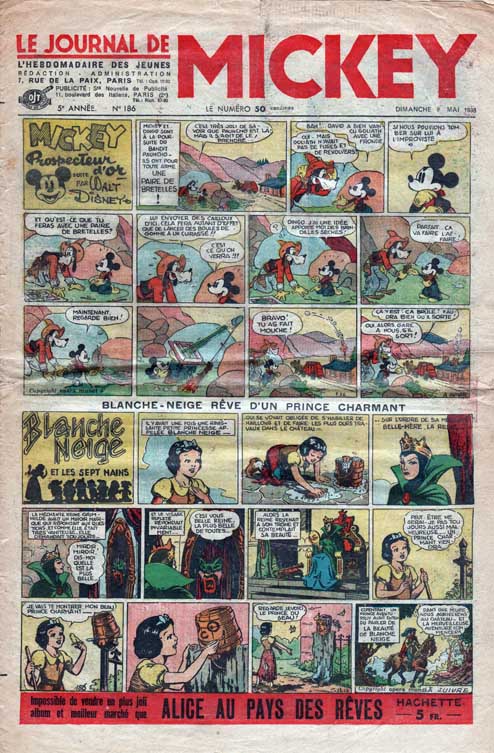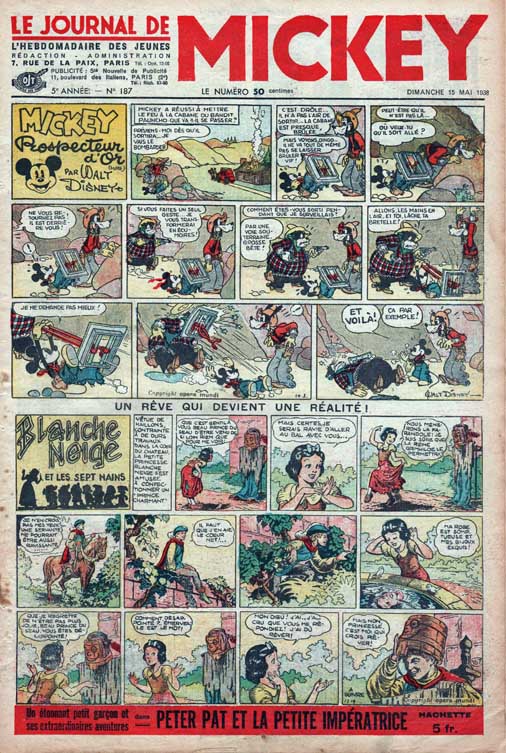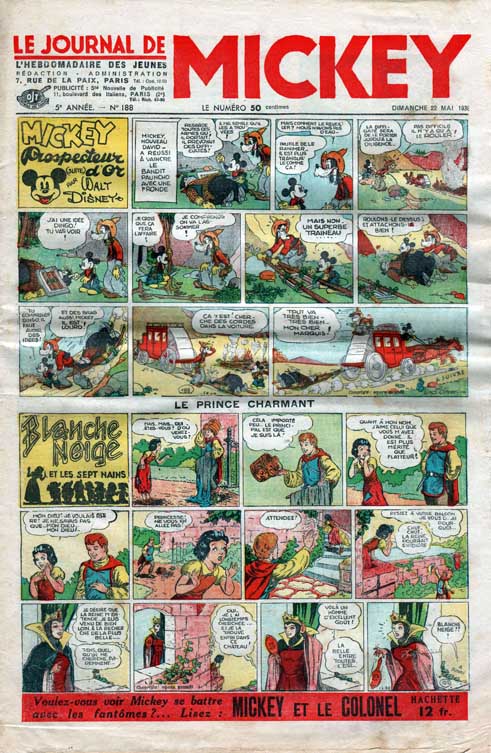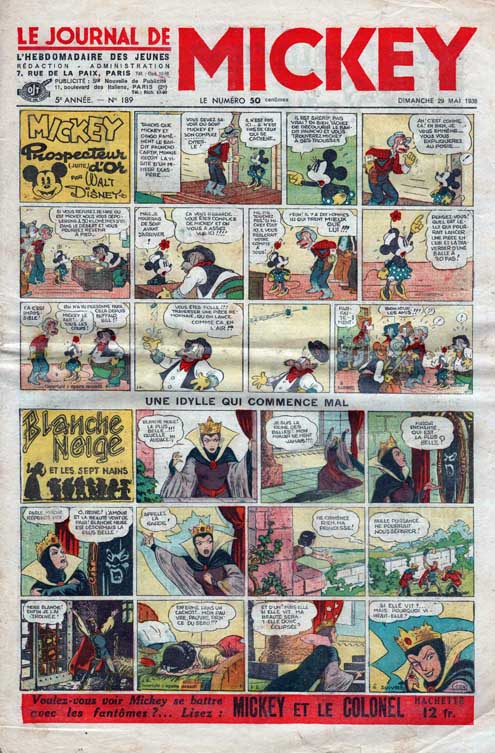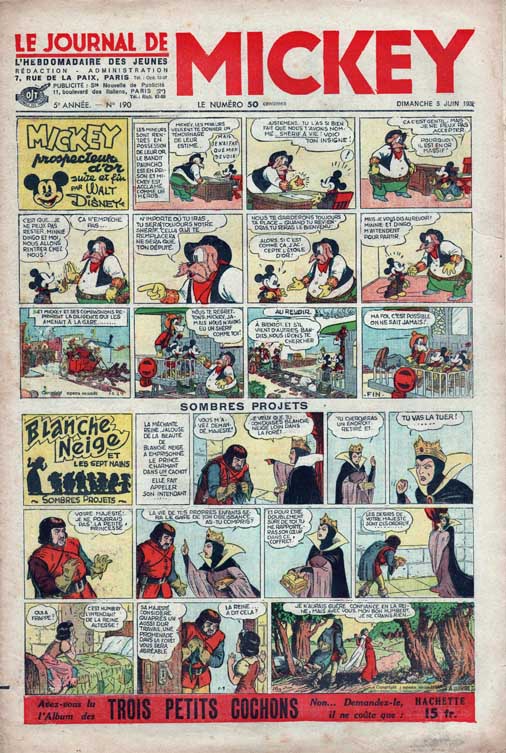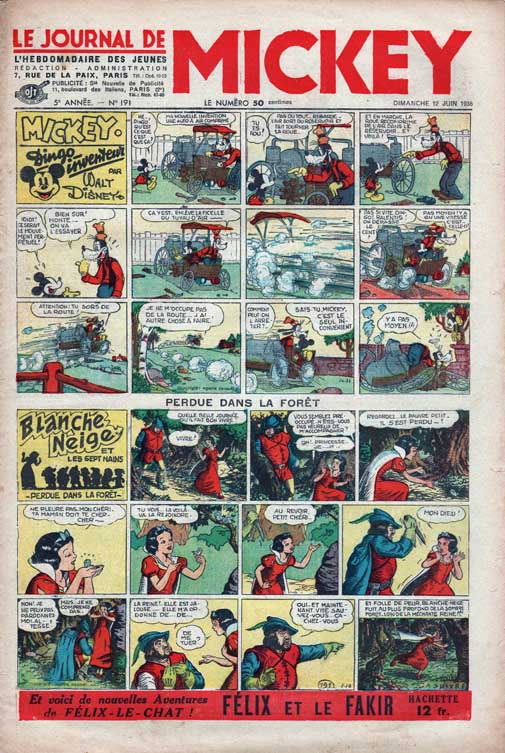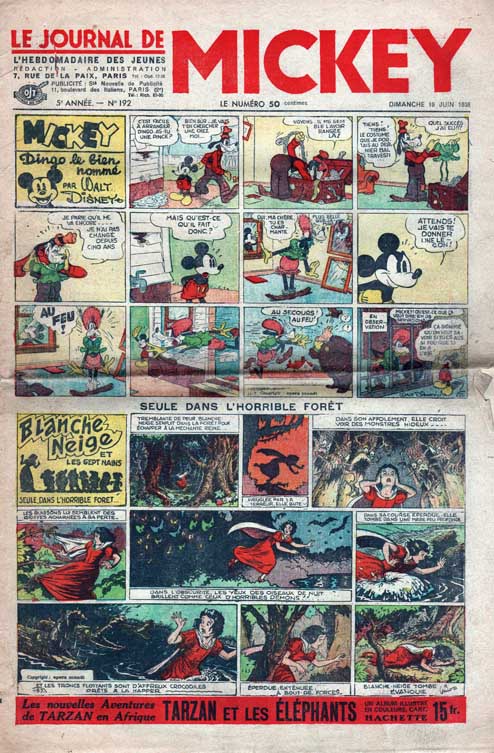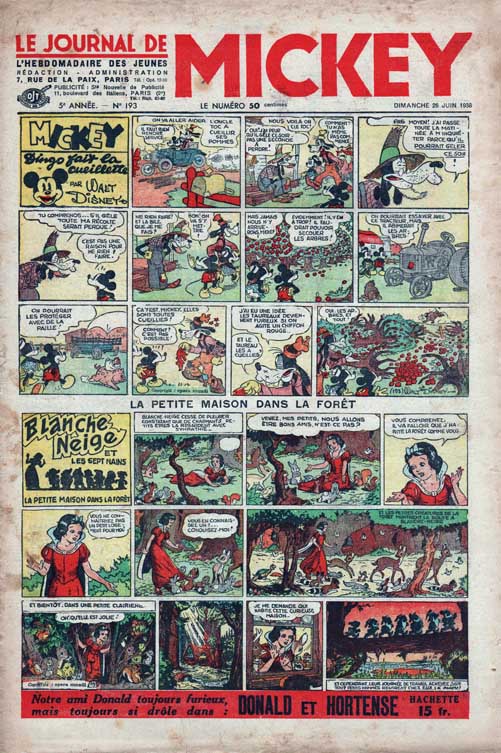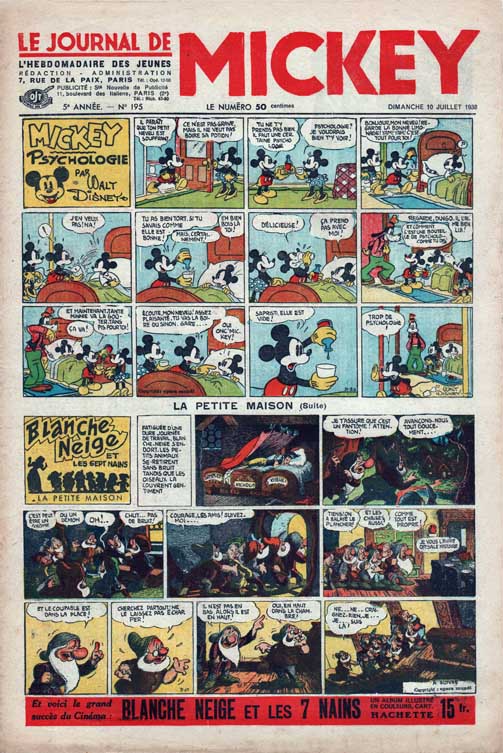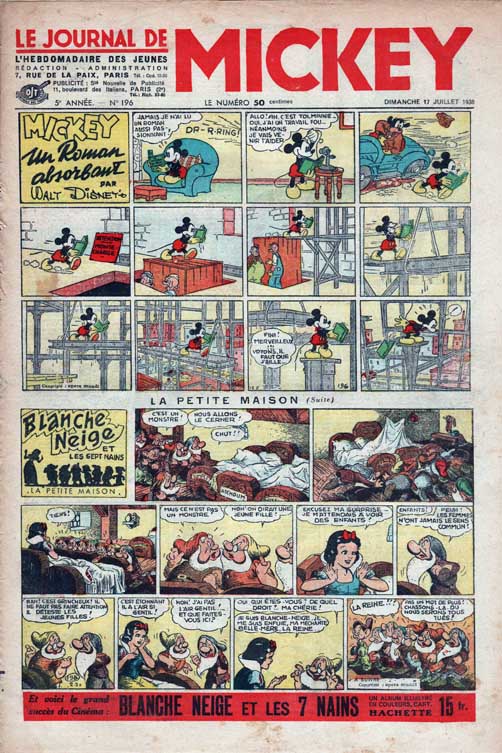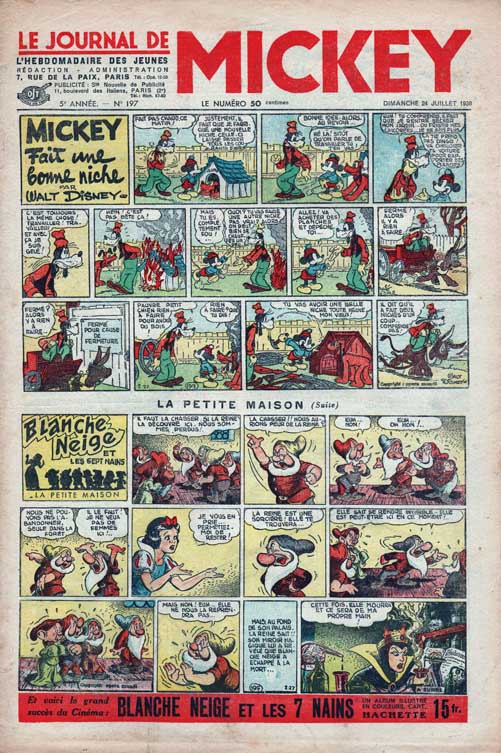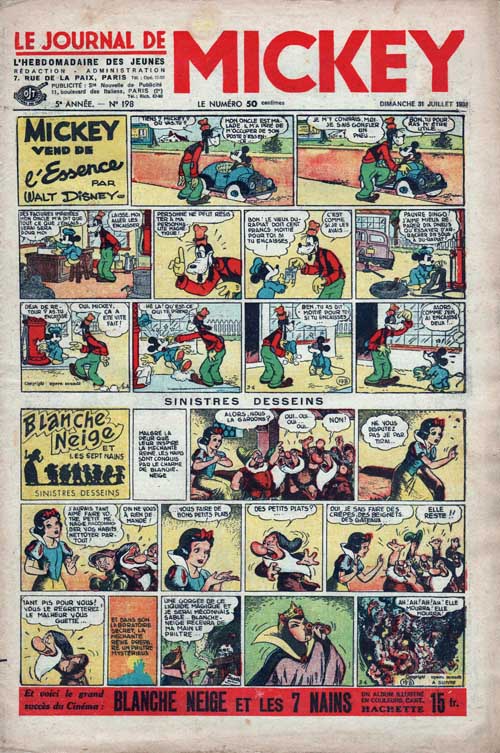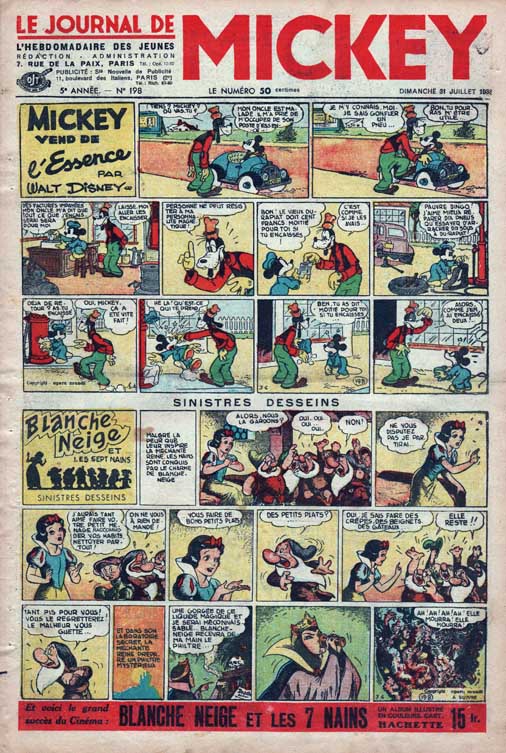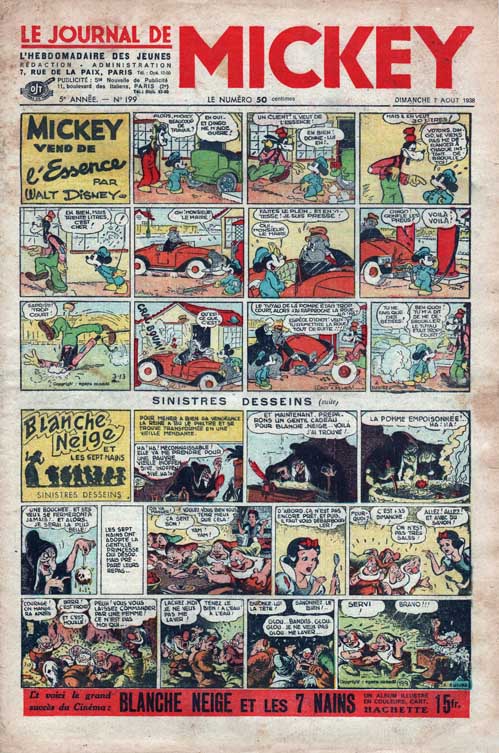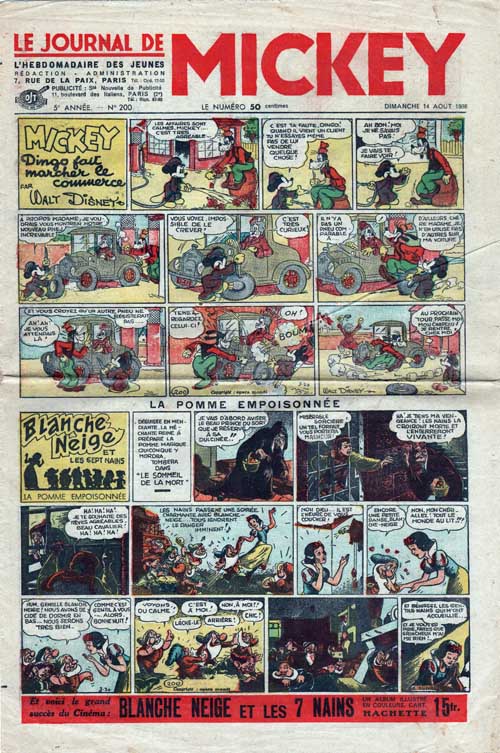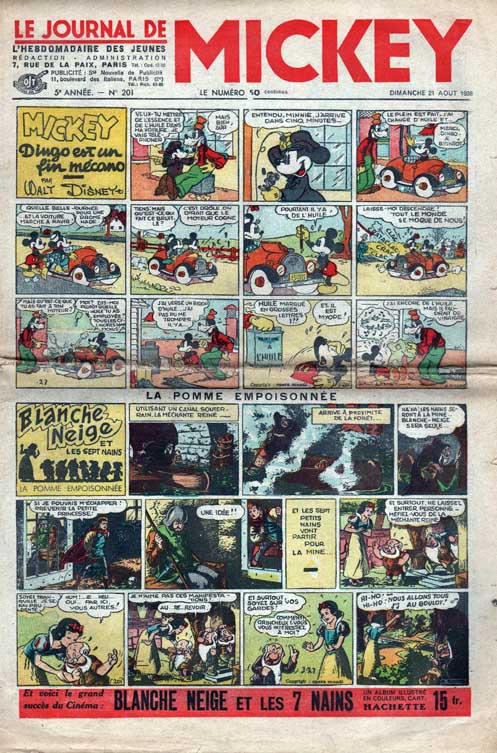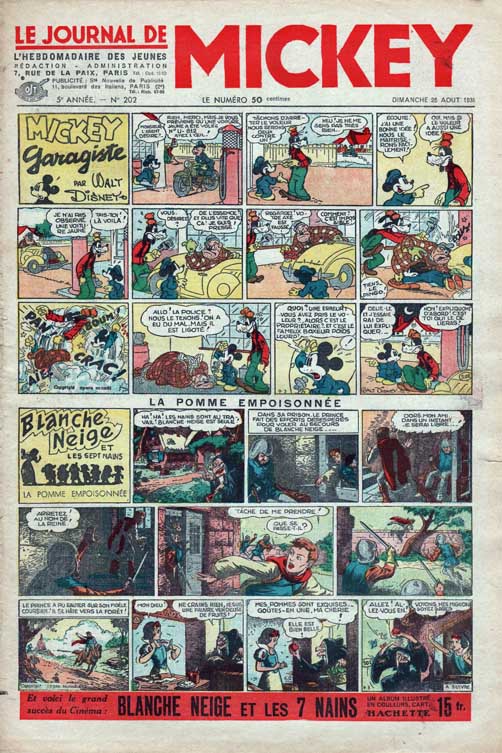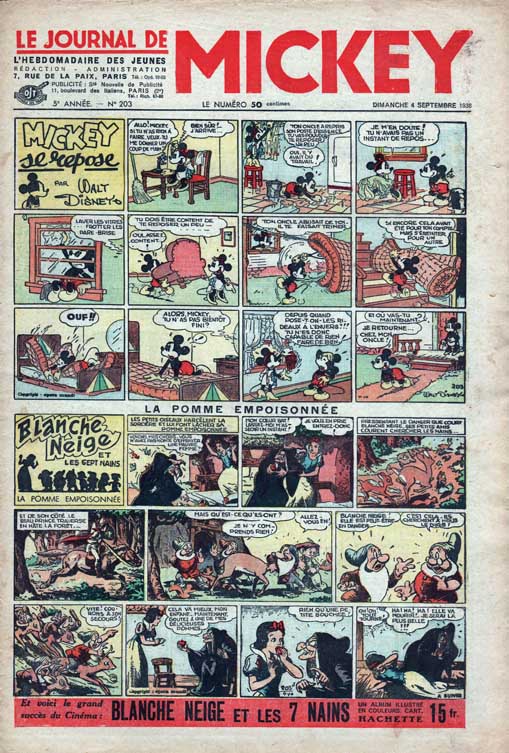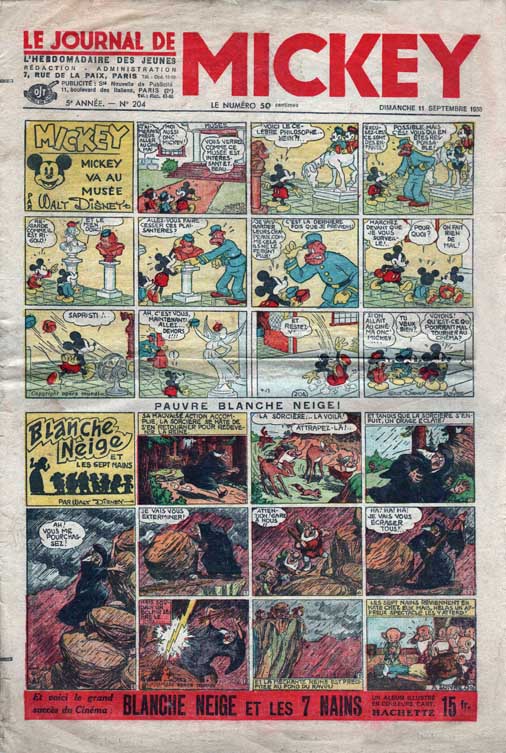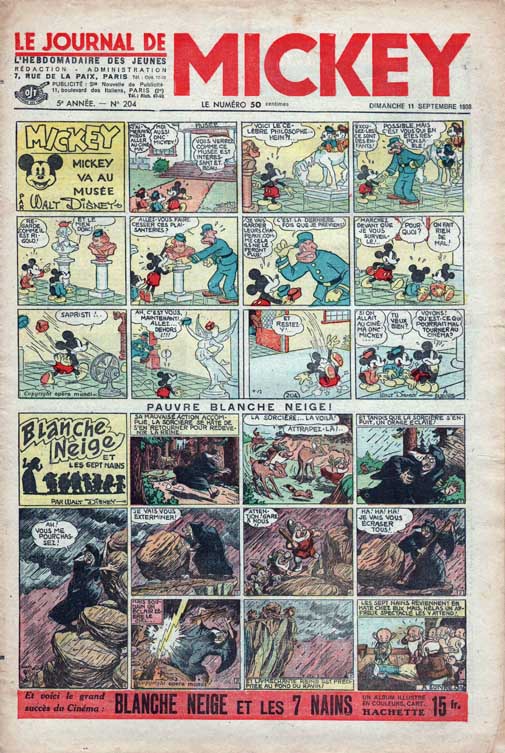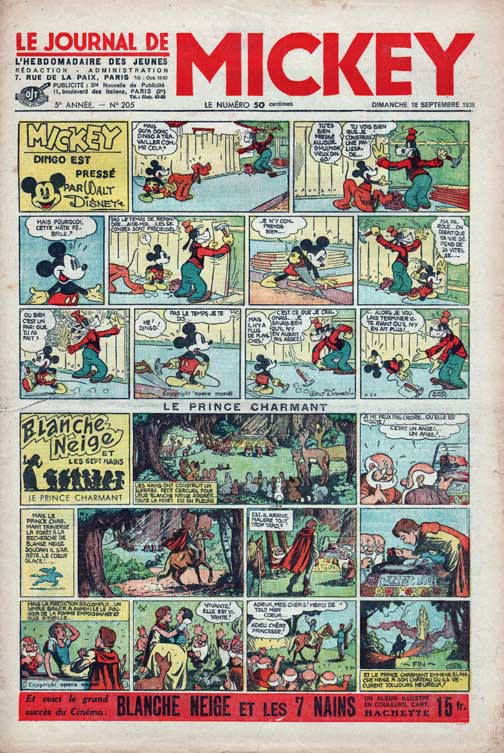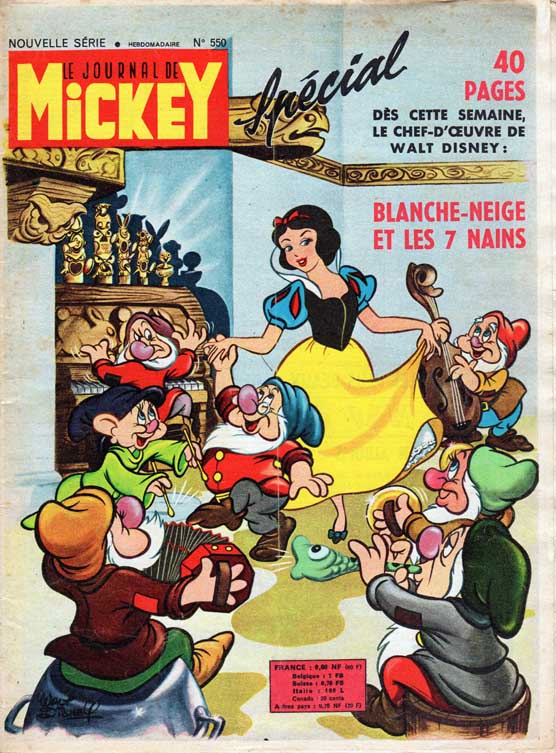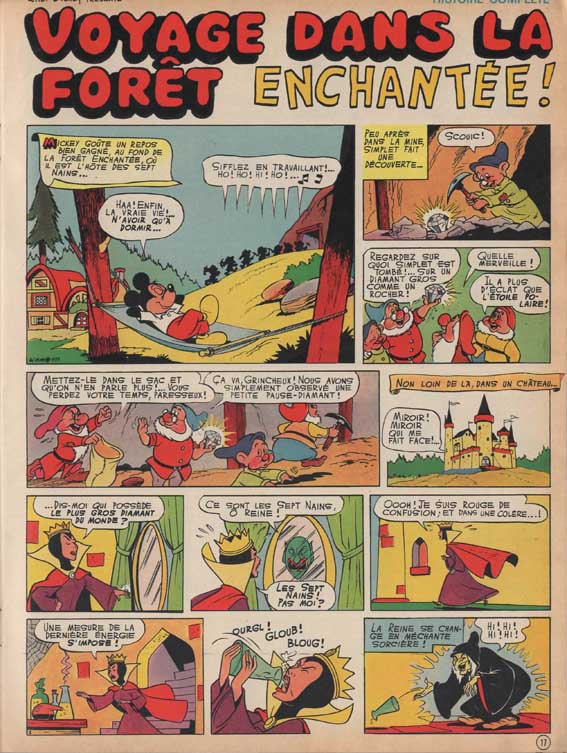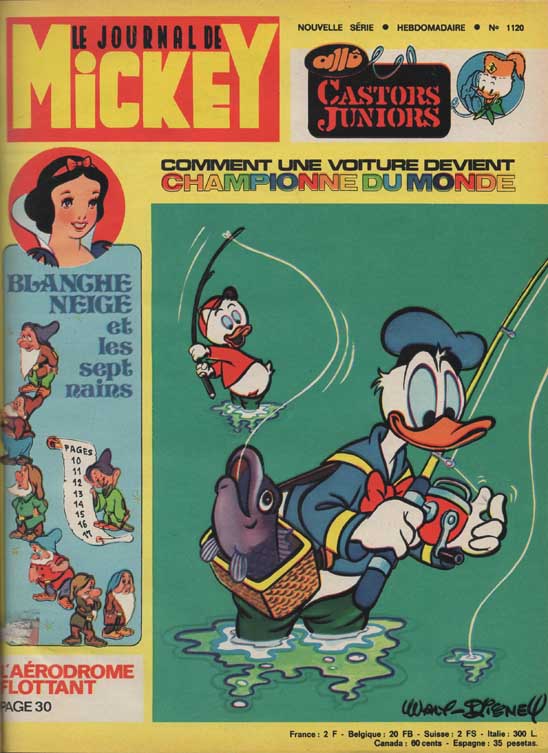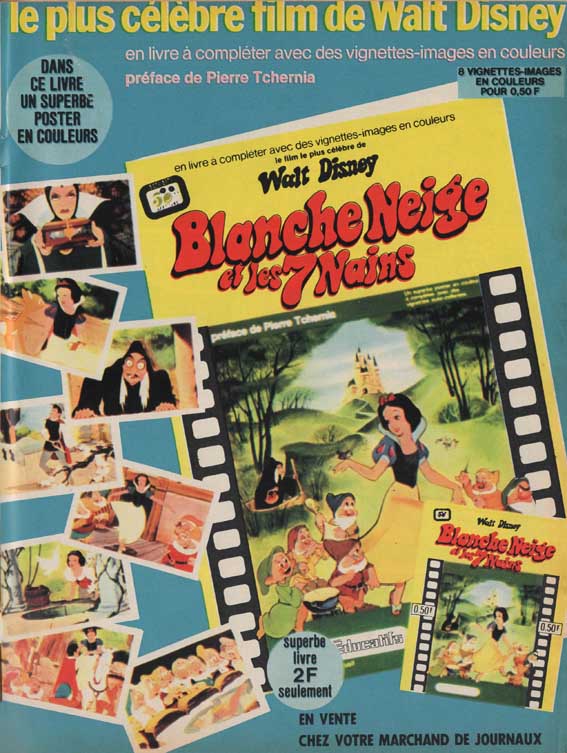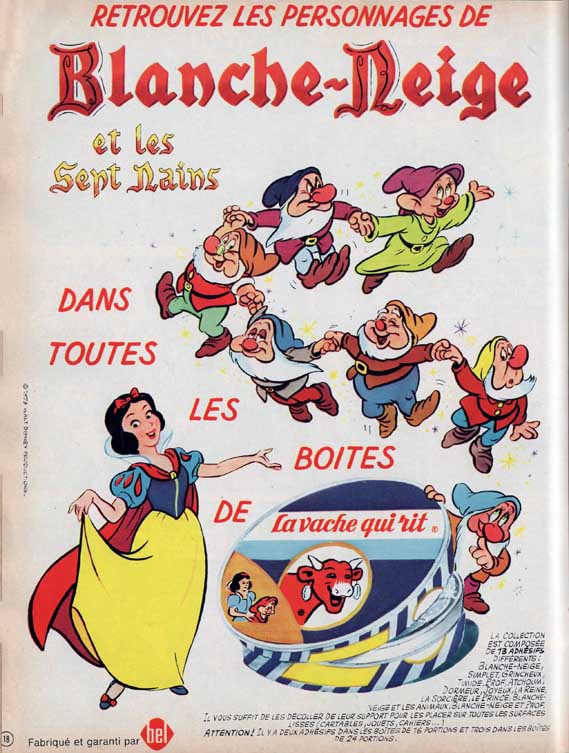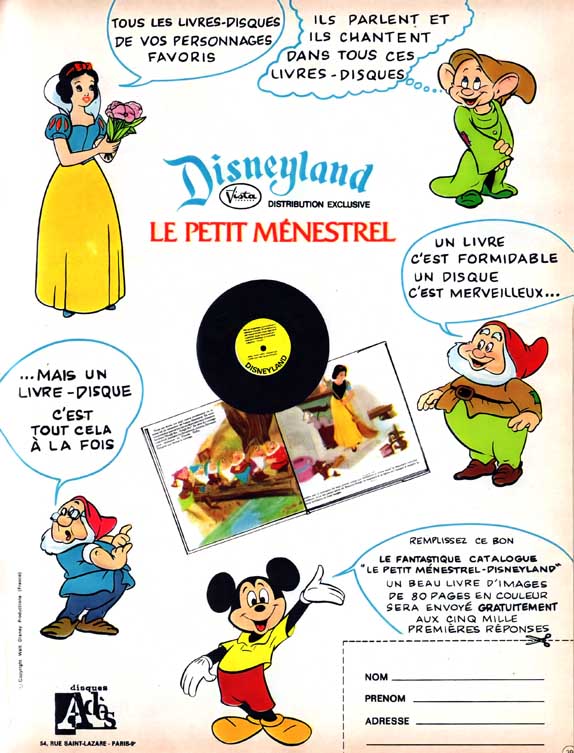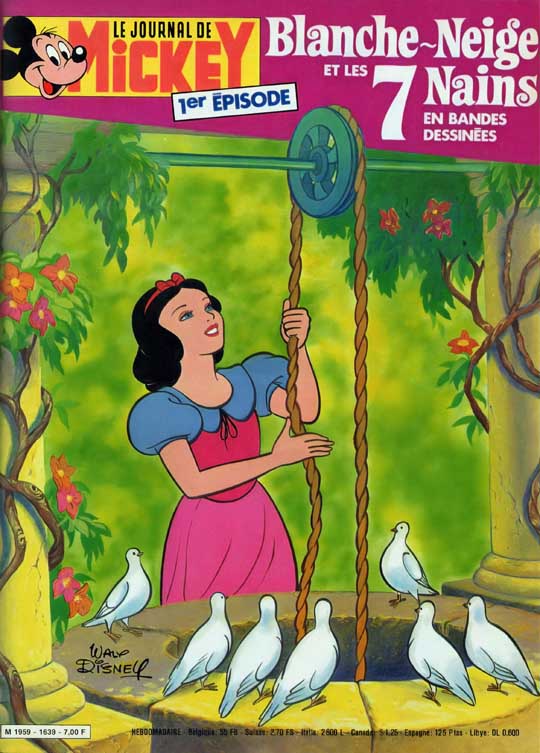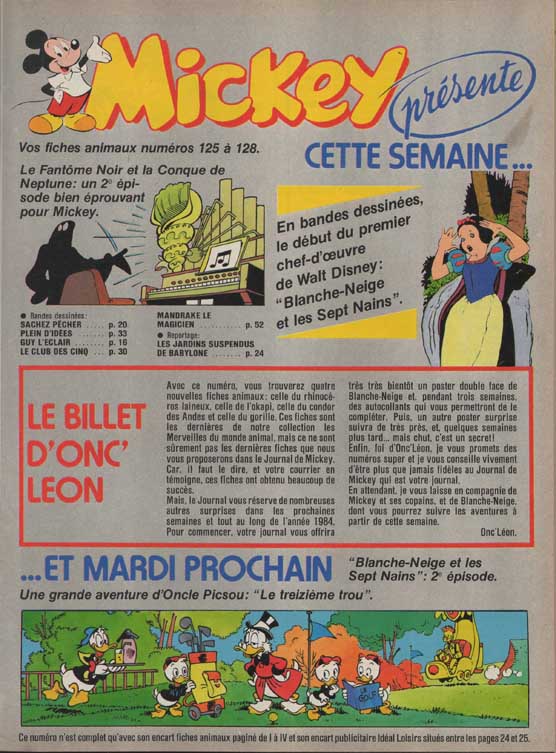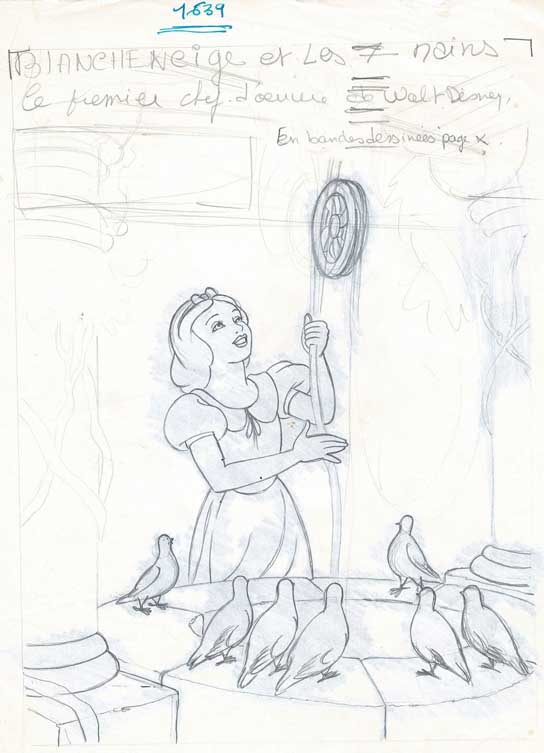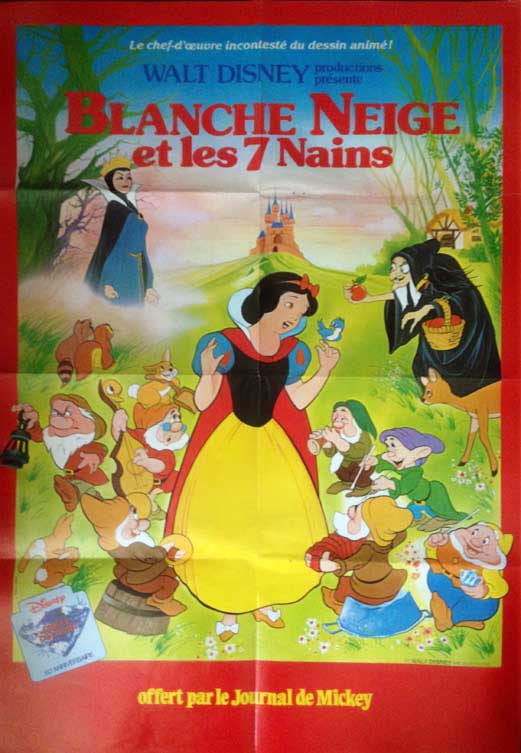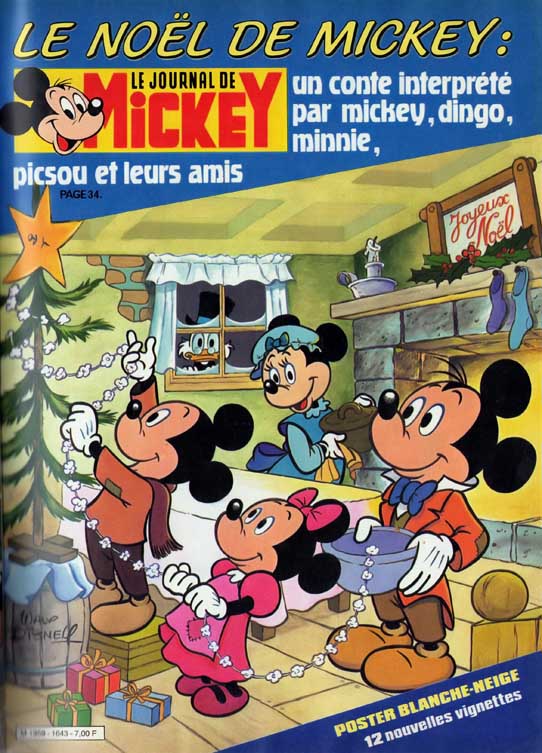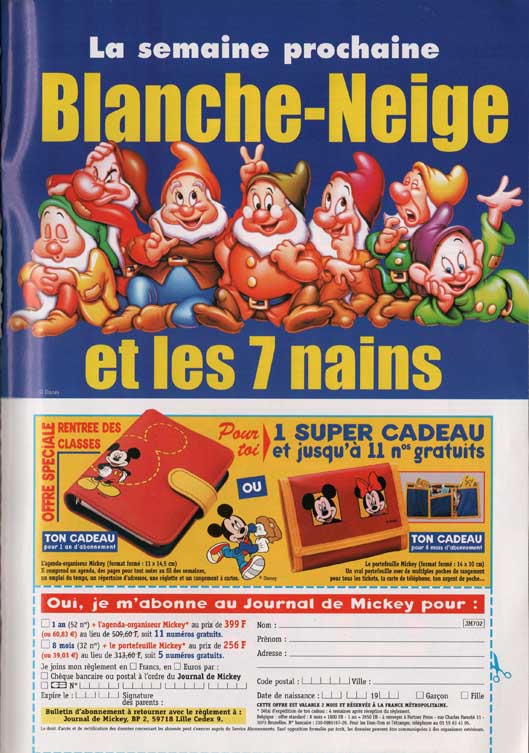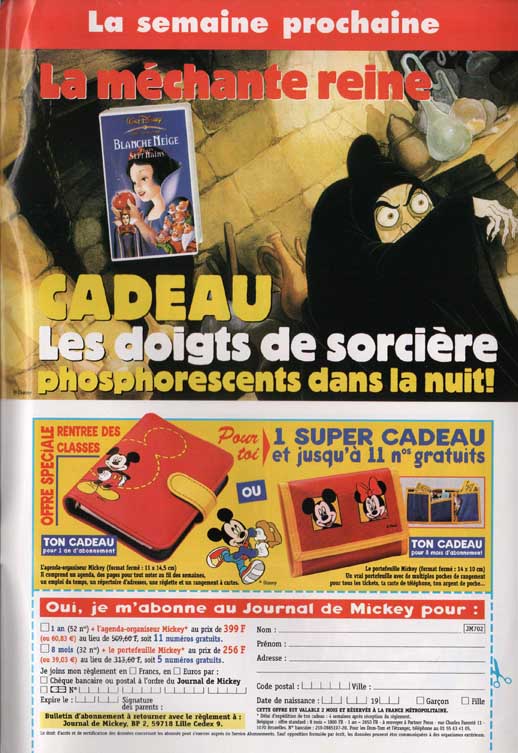
Le Journal de Mickey debuted on October 21, 1934, under the direction of Paul Winkler. With its innovative 28 x 42 cm format and unique content, it revolutionized the children’s illustrated press market in France. The publication stemmed from agreements with Walt Disney and King Features Syndicate, facilitated by Opera Mundi. Before its release, American comics were rarely seen in France.
The journal featured original American stories:
- Page 1: Silly Symphonies and The Adventures of Mickey (Walt Disney).
- Inner pages: Works by C.D. Russell, Hoben, and, starting with issue #25, the Katzenjammer Kids (Pim Pam Poum).
- Page 8: Little Annie Rooney.
Black-and-white pages were devoted to stories, games, and riddles.
Developments Before the War (1936–1940):
The creation of Robinson in 1936 led to some series, like Jim la Jungle, moving to the new journal. Despite this, Le Journal de Mickey remained stable, introducing new content such as the Three Little Pigs and special 16-page holiday editions for Christmas and Easter. New characters like Cora and Marc Luron also debuted. The publication continued uninterrupted until June 1940, despite the looming war.
Wartime Period (1940–1942):
After a brief suspension due to the German occupation, the journal resumed in September 1940 in the Free Zone, now printed in black and white. Some series were discontinued (Jim la Jungle), while others, like Prince Valiant, were introduced. In 1942, wartime restrictions forced a smaller format, and publication ceased entirely by 1944.
Post-War Revival (1952 and Beyond):
In 1952, Le Journal de Mickey was revived in a new, humor-focused format published by Edi-Monde. With a smaller size (24 x 31 cm) and 16 pages (8 in color), it included series like Little Annie, Donald Duck, and Mickey stories. This revival ensured the journal’s longevity, still published today.
Snow White in Mickey’s newspaper
Since 1938, Mickey Mouse’s newspaper has been an effective relay for Snow White’s various screen releases, publishing comic strip adaptations in its pages.
Obviously, as the magazine was not published between 1945 and 1951, the general reissue of the film in France in 1951 could only be exploited in Belgium, where Mickey Magazine inspired Le journal de Mickey in France.
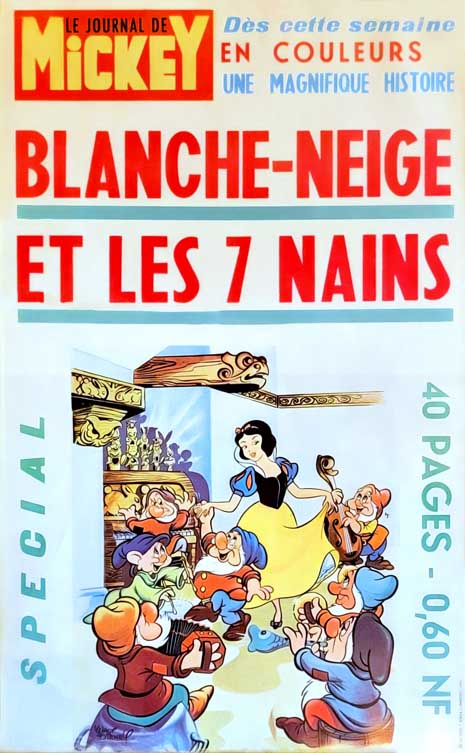
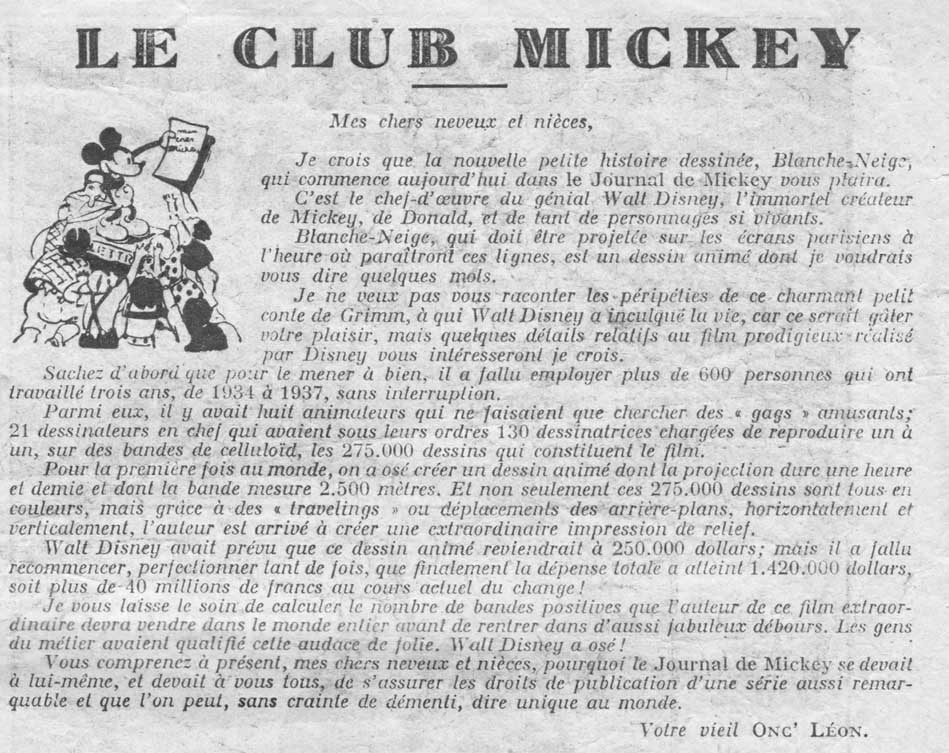
The 1938 comic strip
by Hank Porter (from May 8, 1938 to September 18, 1938)
On May 8, 1938, the first of 22 strips was published, based on the King Features Syndicate comic strip, along with this text signed “Onc’ Léon” (Uncle Leon).
I believe that the new illustrated story, Snow White, which begins today in the Journal de Mickey, will please you.
It is the masterpiece of the brilliant Walt Disney, the immortal creator of Mickey, Donald, and so many other lifelike characters.
Snow White, which is scheduled to be shown on Parisian screens at the time these lines appear, is an animated film I would like to tell you a few words about.
I don’t want to spoil the adventures of this charming little Grimm tale, which Walt Disney brought to life, as that would ruin your pleasure, but I think some details about Disney’s prodigious film will interest you.
First of all, you should know that to accomplish it, more than 600 people worked non-stop for three years, from 1934 to 1937.
Among them, there were eight animators who focused solely on finding amusing “gags”; 21 chief illustrators who supervised 130 female artists tasked with reproducing, one by one, on strips of celluloid, the 275,000 drawings that make up the film.
For the first time in the world, someone dared to create an animated film with a projection time of an hour and a half and a film strip measuring 2,500 meters. Not only are these 275,000 drawings all in color, but thanks to “traveling shots” or background movements, horizontally and vertically, the creator achieved an extraordinary impression of depth.
Walt Disney initially estimated that this animated film would cost $250,000; but they had to redo and perfect so many times that the total expense finally reached $1,420,000, or over 40 million francs at the current exchange rate!
I leave it to you to calculate how many positive prints the creator of this extraordinary film will need to sell worldwide to recover such fabulous expenses. Industry experts had labeled this boldness as madness. Walt Disney dared!
You now understand, my dear nieces and nephews, why the Journal de Mickey owed it to itself, and to all of you, to secure the publication rights for such a remarkable series, which, without fear of contradiction, can be described as unique in the world.
Your old Uncle Léon.
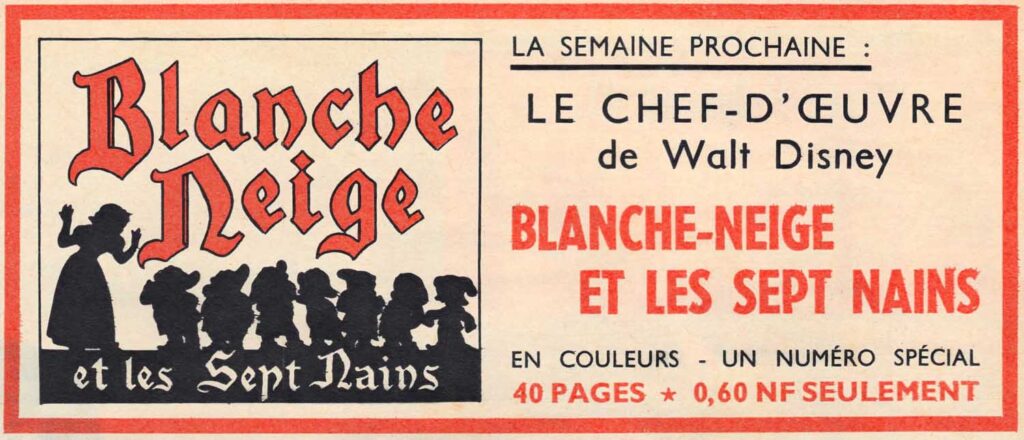
The 1962 comic strip
by Hank Porter (from December 9, 1962 to March 24, 1963)
On December 2, 1962, in number 549 of the magazine, a small insert announces the publication of the same comic strip in the next issue on December 9 with n°550 and the publication goes on for 15 weeks. This time, a new translation is provided.
The cover is most likely drawn by René Guillaume, the magazine’s regular cover artist at the time.
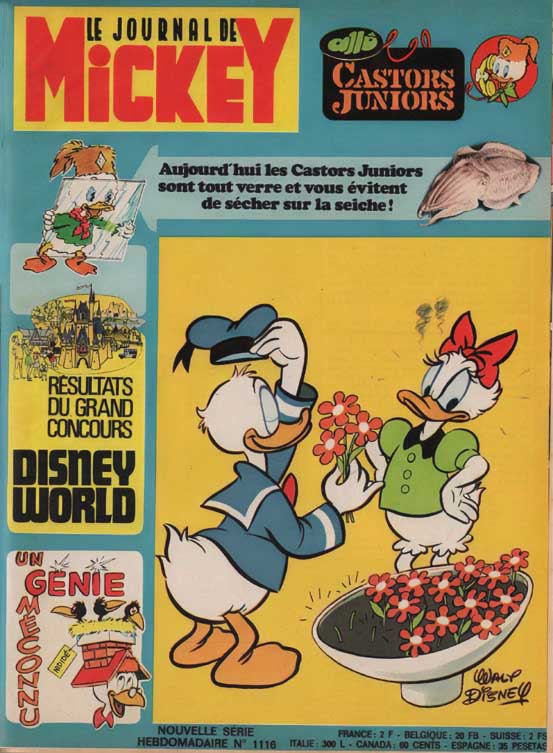
Journey through the enchanted forest
by Unknown artist (on November 4, 1973)
On November 4, 1973, a full Mickey Mouse comic strip is published in Mickey’s Newspaper: Journey through the Enchanted Forest.
In it, the Queen discovers, thanks to her magic mirror, that the dwarfs possess the biggest diamond in the world. To obtain it, she transforms herself into a witch, makes seven poisoned apples and sells them to Mickey Mouse, who is resting in the seven dwarfs’ cottage and is in charge of preparing lunch for them. When he discovers his mistake, it’s too late. Mickey goes to find the Prince, who kisses each dwarf without success.
Meanwhile, the Queen has fitted the diamond into a crown so heavy that she falls from her balcony. Bambi warns Mickey, and when he reaches the Queen lying in the grass, Madam Mim appears and heals the Queen with a potion. But she has lost her memory and Madam Mim makes her believe she is Viviane, the good fairy of Broceliande. Mickey then shows Madam Mim that Snow White and the Prince’s kisses are powerless to wake them up, to which Madam Mim replies that all it takes is a slap.
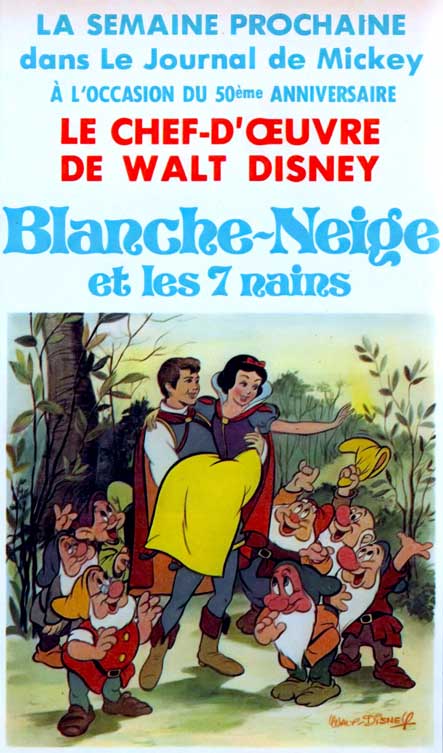
The 1973 comic strip
by Unknown artist (from November 25, 1973 to December 16, 1973)
On November 11, 1973, an advert warned readers that for the studios’ 50th anniversary, and as the film returned to French movie theaters, Mickey’s Newspaper would be publishing the story of Snow White and the Seven Dwarfs.
The cover of the n°1119 issue of November 25, 1973 is most likely drawn by René Guillaume, the magazine’s regular cover artist at the time. A new comic strip starts on 4 double pages that week. In that issue, a centerfold poster if offered of the dwarfs showing their hands to Snow White.
The comic strip itself, although new, is still heavily indebted to the original King Features Syndicate comic strip.
Uncle Léon’s post that week reads:
ONCE UPON A TIME… there was a very beautiful princess.
Her name was Snow White. Thus begins the story, or rather, the tale of “Snow White and the Seven Dwarfs,” once imagined by the Brothers Grimm. Thanks to Walt Disney’s famous animated film, Snow White and the Seven Dwarfs would come to life in 1937.
Thirty-six years later, as you’ll notice in this issue where their adventures begin, Snow White and the seven dwarfs haven’t aged a bit or turned a single hair gray…
Like La Fontaine’s Fables or Ronsard’s verses, Snow White cannot age because, in verse, in image, or in music, poetry is eternal. It truly is poetry, a dream: we feel fear with Snow White, we shiver before the witch, we laugh with Dopey; in short, we take part in the dream, we live it.
Even though we live in a world where “there’s no time for anything,” we love to escape, to go far away, to dream of other places. And what more beautiful place could we dream of than plunging into the marvelous universe of Snow White and her little companions?
Dreaming is more than just an ability; it’s a necessity. Physiological researchers have proven that if a person is prevented from dreaming while asleep, they may risk dying. Poets, on the other hand, have this precious ability to dream even when they are awake and to invent, inspired by their imagination, a magical world into which they draw us along with them.
Our Walt was a pure poet, and there’s no need to look elsewhere for the reason why his characters became famous around the entire world.
In addition to the comic strip, issue no. 1120 of December 2, 1973 featured an advert for The Laughing Cow cheese, and another for the Agéducatif sticker album, reflecting the marketing strategy behind the film’s theatrical release.
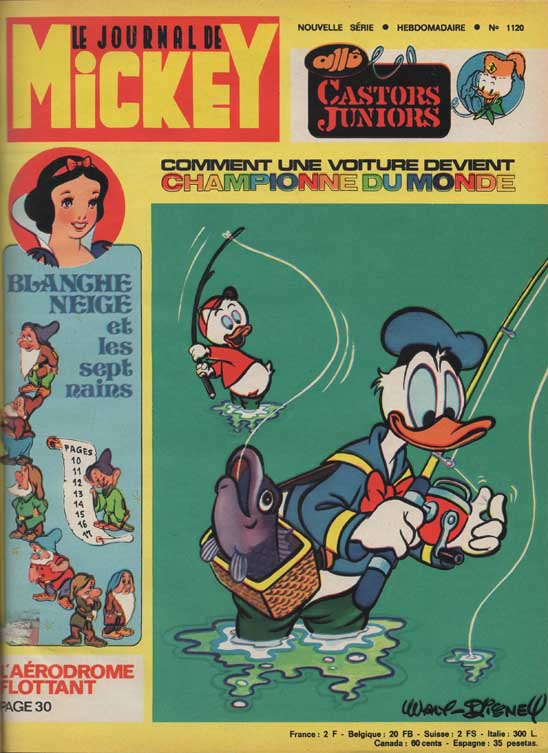
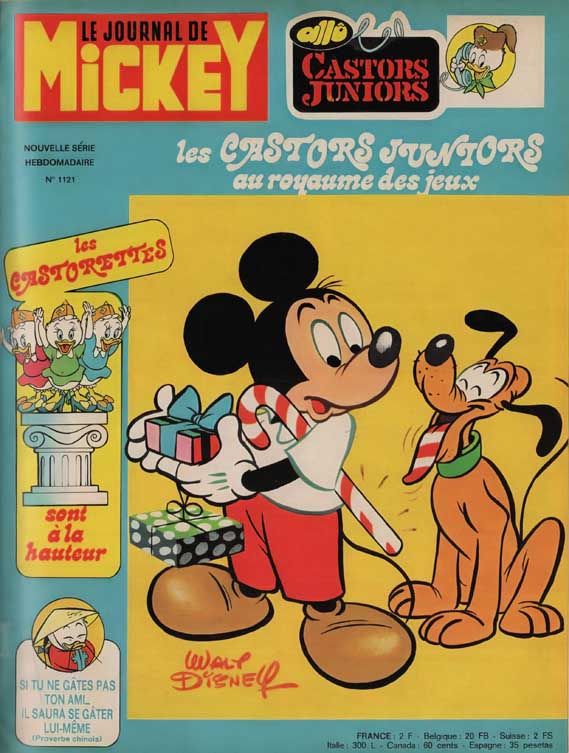
Besides another laughing cow cheese ad, this December 9, 1973 issue n°1121 contains the third partof the Snow White comic strip where the dwarfs decide to keep Snow White with them, and the Queen transforms into an old hag.
With the fourth and last part of the Snow White comic strip published in the December 16, 1973 issue of Mickey’s Newspaper, three interesting ads are included: once again, one for The Laughing Cow cheese, one for the comic strip in book form so that young readers can own what they have just read in a more luxurious format, and finally one for the book The Fabulous Story of Mickey, a large format book that includes 15 complete Mickey Mouse comic strips and the story of Mickey Mouse.
The cheese ad will be published in the next two issues of the magazine, and the December 30, 1973 issue (n°1124) even has an ad for The Little Minstrel record.
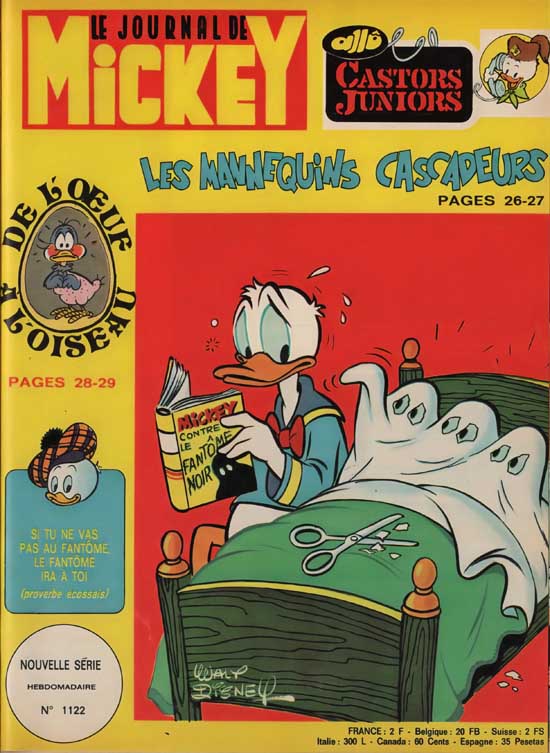
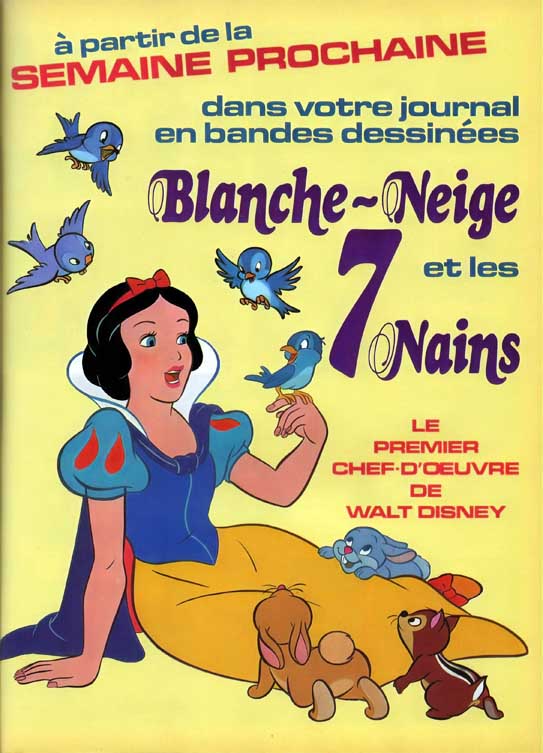
The 1983 comic strip
by Unknown artist (from November 28, 1983 to December 18, 1983)
On November 21, 1983, an advert warned readers that, as the film returned to French movie theaters, Mickey’s Newspaper would be publishing the story of Snow White and the Seven Dwarfs.
This time, the covers of the next four issues are dedicated to Snow White. The head illustrators then are Patrice Croci, Victor Lagoutte, Marie Dalla-Pozza and Éric Bévilacqua. The first cover’s layout drawing was sold on Drouot.com in 2024.
Uncle Leon’s post is:
(…) But the Journal has many more surprises in store for you in the coming weeks and throughout the year 1984. To start, your magazine will very soon offer you a double-sided Snow White poster and, for three weeks, stickers that will allow you to complete it. Then, another surprise poster will follow very soon, and a few weeks later… but shh, that’s a secret!
Finally, by Uncl’ Léon’s word, I promise you fantastic issues, and I strongly encourage you to remain as loyal as ever to the Journal de Mickey, which is your magazine.
In the meantime, I leave you in the company of Mickey and his friends, and of Snow White, whose adventures you will be able to follow starting this week.
The second episode of the comic strip, published on December 4, 1983 in the n° 1640 issue. On page 29, there is an ad for the next issue that contains a double-sided poster and twelve first stickers to complete the picture.
There is also an ad for a videocassette of the clip show Disney’s Greatest Dog Stars. More importantly on page 45 is what looks like a complete list of all the movie theaters in France where the film is shown from November 30, 1983.
On page 48 is an ad for the Ades records of Snow White and the Seven Dwarfs and Return of the Jedi. They are:
- Snow White and the Seven Dwarfs by Bernard Giraudeau
- Snow White and the Seven Dwarfs by Marie-Christine Barrault
- Snow White and the Seven Dwarfs by François Périer
- Snow White and the Seven Dwarfs (Original soundtrack)
- Songs by Marie Myriam
- Marie Myriam sings Snow White
- The Seven Dwarfs sing
- Marie Myriam sings Snow White (LP)
Uncl’ Léon’s post that week read:
Starting this week, on many screens across France, you will be able to see and rewatch Snow White and the Seven Dwarfs by Walt Disney.
Snow White was Walt Disney’s first major animated feature, and also, it can be said, the first masterpiece in an impressive list.
It all began in 1931, almost 53 years ago. That year, Walt and his team read the tale by the Brothers Grimm. Ideas were proposed, and a script was imagined. Three years later, in 1934—exactly 50 years ago—the film was launched. It took a large team of animators three years to create the film that you will see or rewatch in the coming days.
But who could imagine, upon seeing it, that this film is fifty years old? No one! Not a wrinkle, nothing!
Yet, fifty years later, Snow White continues to inspire dreams, laughter, and tears. This is thanks to the talent and genius of Mr. Disney, a man who, in his life and works, was always ahead of his time.
Though Walt Disney is gone, his spirit continues to reign in the studios, where everyone strives to do only what Walt would have done!
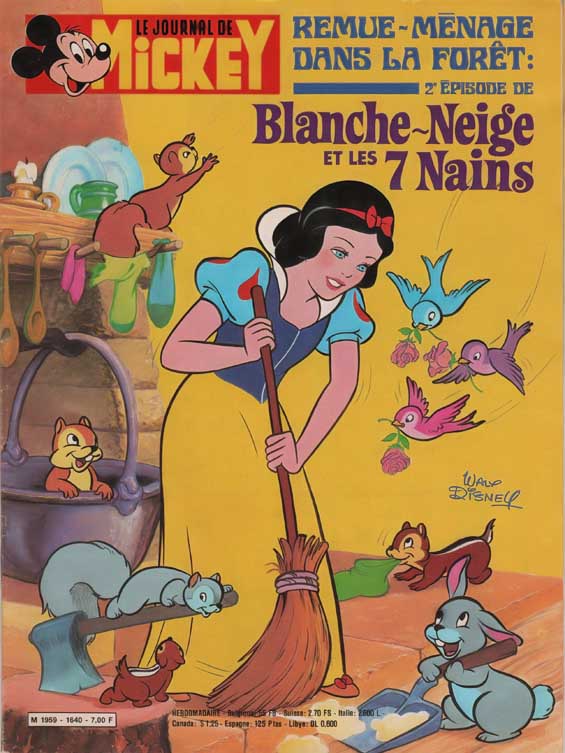
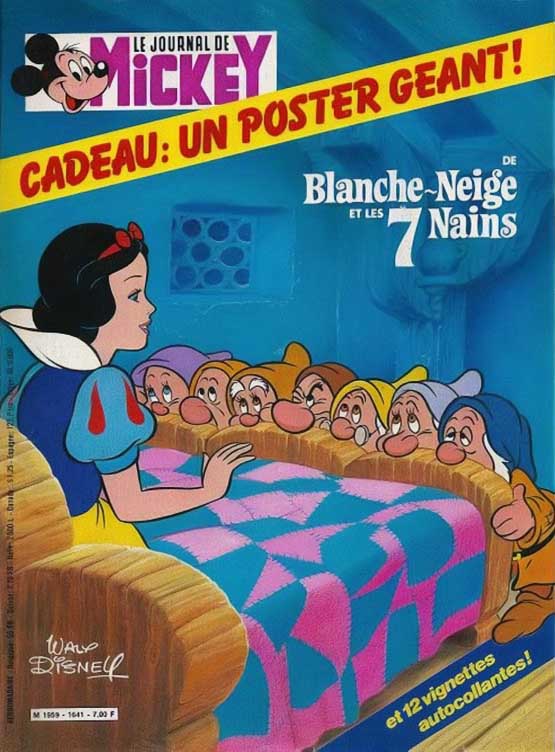
As promised, the n°1641 issue of Mickey’s Newspaper, published on December 11, 1983 contained, not only the third episode of the comic strip of Snow White, but also a large two sided poster. One had to collect 36 stickers to complete the reverse image, 12 of which were included in the magazine. The front side was a reproduction of the theatrical poster of the then current re-release of the film.
Uncl’ Leon had this to say:
You cannot imagine how happy I am to offer you this week’s issue.
For several reasons: As you’ve seen, it’s an issue that includes a giant Snow White and the Seven Dwarfs poster as a gift.
I don’t know if you’re like me, but I take more pleasure in giving than in receiving, and you’ll understand my joy this week.
Another reason: Perhaps the most important. A gift is usually given to celebrate someone, but also to thank them. And this poster is our way, at Journal de Mickey, of thanking you for your loyalty. It’s a small thing—though many gifts will soon accompany Journal de Mickey—but as they say, it comes from the heart…
The last episode of the Snow White comic strip is offered in the n°1642 issue of Le Journal de Mickey of December 18, 1983, along with the cottage of the seven dwarfs that one can built with pages 15 to 17 of the magazine.
On page 20 is another ad for the very same Ades records seen previously, but with a reproduction of the one with the story told by Bernard Giraudeau, recorded that year.
There is also an anouncement for the coming comic strip adaptation of Mickey’s Christmas Carol, which came out that year in the same program with Snow White.
12 additional stickers are also included in the magazine for the poster in the previous issue. The last 12 remaining stickers were in the n°1643 Christmas issue of the magazine.
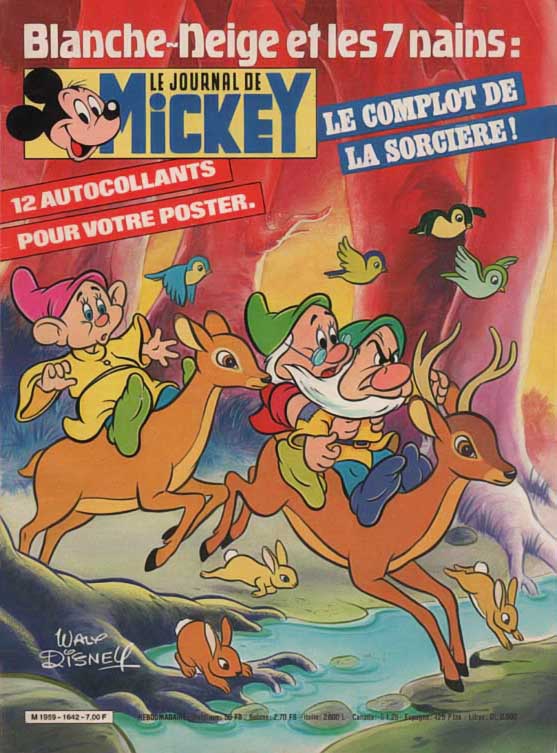

Apples, apples, apples, apples
by Unknown artist (January 8, 1984)
On November 21, 1984, in the section “Hello Junior Woodchucks” which gathers miscellanous facts, the hag illustrates this text:
The Golden Delicious still reigns supreme in France’s basket… of apples. Two out of three apples produced are Golden, and although they don’t have unanimous approval among gourmets, of every two apples bitten into, one is a Golden… In any case, don’t even think about it! The poisoned apple from the wicked witch in Snow White and the Seven Dwarfs definitely wasn’t a Golden Delicious… That’s for sure!…
Snow White and the Seven Dwarfs Are Back!
by Unknown journalist (February 7, 1992)
Snow White’s last general outing comes as the 1992 Winter Olympics dominate the headlines. Mickey’s Newspaper is no exception, but of course the cover promises “all the secrets of the film”. In fact, a long illustrated article and inserts dedicated to the cartoon feature precede a review of the film by Christian Jauberty in the pages of the magazine.
Snow White and her seven little friends are back on our screens! It’s an event! Snow White has remained a modern character, and more than 50 years after its first release, Walt Disney’s film has retained all its freshness and enchantment. The proof? Songs like “Heigh-ho”, “Some Day My Prince Will Come” and “Whistle While You Work” are still hits today. In short, a true fairy tale that will enchant you as it enchanted your parents.
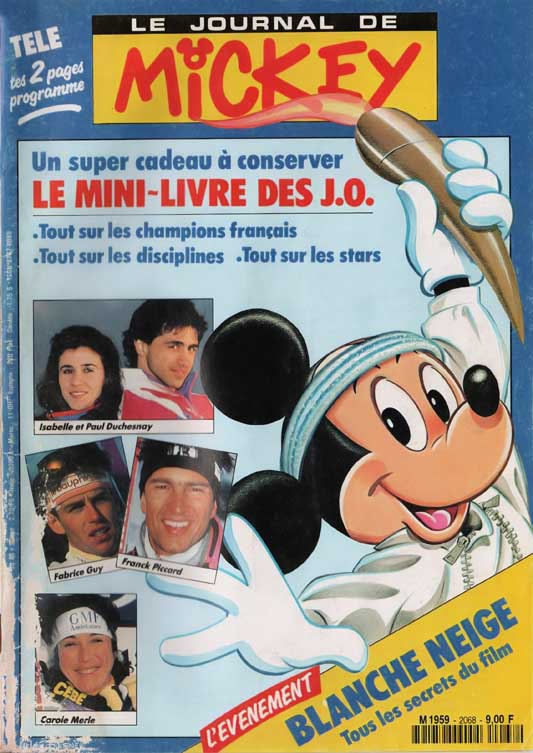
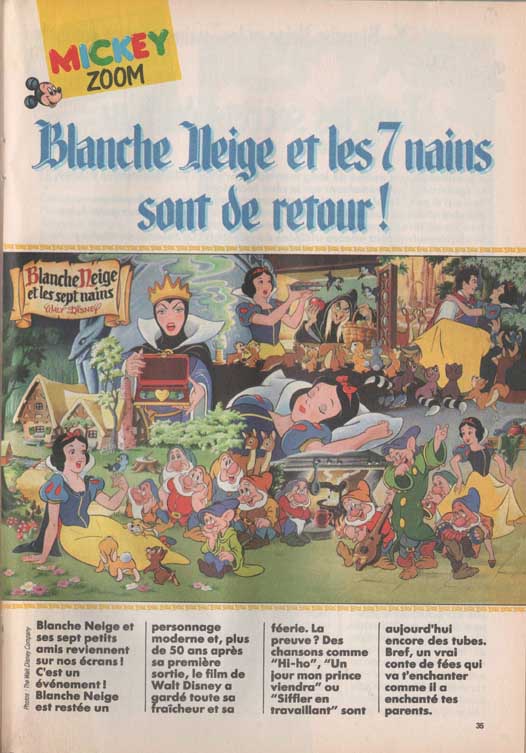

All the secrets of the film
This first animated feature film, released in 1937 by the Disney studios, was also a technical event. Over four years, dozens of illustrators, colorists, and animators created the film, inventing new techniques to bring the various characters to life. Some of these revolutionary techniques are still used today. The Journal de Mickey reveals everything about the making of this masterpiece.
Snow White
Young and beautiful princess, she is pursued by a cruel curse.
She is the main character of the film. Snow White had already been brought to the screen, for example, in 1916, when actress Margaret Clark played the role of Snow White. It was after seeing this film that Walt Disney got the idea to adapt the famous Brothers Grimm tale into an animated feature.
The animators at Disney studios faced challenges in creating their first human character (their previous “works” were animals or imaginary creatures, which were easier to draw or caricature, like Mickey Mouse!).
The Disney “artists” used some clever tricks, particularly to give Snow White’s face a fresh and natural complexion: instead of using some of the 1,500 colors developed in the studio’s laboratories, they used the women’s makeup products from the team!
A Golden Voice
Not wanting to be influenced by appearances, Walt Disney refused to see the singers auditioning to be the voice of Snow White. It was solely by listening to their recordings that he chose Adriana Caselotti.
Some Numbers
Snow White represents:
- 2,450 meters of film reel
- 1,000,000 drawings
- 120,000 frames, 1,500 different colors, and 4 tons of paint!
- It also involved 750 “artists” (from all disciplines) and an orchestra of 80 musicians!
The Prince Charming
As his name suggests, he charms Snow White.
However, Walt Disney quickly decided to reduce his role to a simple appearance at the beginning of the film and the final scene where he “awakens” the princess from her “eternal sleep.” In the Brothers Grimm story, the Prince saves Snow White by lifting her in his arms, which helps her dislodge the poisoned apple. Walt Disney preferred the idea of the kiss—definitely more romantic, don’t you think?
The Queen
Jealous of Snow White’s beauty, she wants to eliminate her.
The scene where this woman, beautiful but with a hard heart, becomes a toothless, hideous witch allowed Walt Disney’s technicians to have a lot of fun while working hard!
Countless meetings preceded the final design of the witch’s crooked nose and wild hair. In an earlier version of the film, the queen-witch was supposed to get rid of Snow White using a cursed comb, but Walt Disney preferred the more original idea of the poisoned apple. That’s how we see the witch, leaning over her bubbling cauldron, joyfully brewing her evil potion! Hee hee hee!!
THE SEVEN DWARFS
They take Snow White in and make her their best friend.
Walt Disney called them the “Seven Little Jewels.” He made them much more important to the story than the Brothers Grimm had intended. To help the animators and designers, Disney created wooden models and hired three real dwarfs (Erny, Tom and Major George). He filmed them in their every day life to give a reference to the animators.
Each of these little characters has a personality and particular physique, symbolized by their names: Doc, Happy, Sneezy, Sleepy, Grumpy, Bashful, and Dopey. The latter is the only one of the seven who doesn’t speak. He’s not mute; he simply doesn’t need words to express himself. His gestures and attitudes prove his character of “young faihful and somewhat crazy puppy dog”. As a matter of fact, like dogs, he can move each ear independently.
7 DWARFS IN GOLD
The very official academy distributing the Oscars in the United States decided to give Walt Disney a special award: eight golden statuettes, one large and seven small!
7 DWARFS IN UNIFORM
During World War II, many soldiers asked Disney studios—and happily accepted—drawings inspired by the dwarfs to decorate their planes and ships!
Snow White Mania!
Snow White and the Seven Dwarfs quickly conquered the screen, making waves in advertising and industrial design. True stars!
A COLOSSAL SUCCESS
On December 21, 1937, at the Carthay Circle in Los Angeles, Walt Disney presented Snow White to an astonished and massive audience! Within three months, 20 million viewers had packed theaters. Translated into 10 languages, shown in 60 countries including China, Snow White became a hero across all demographics!
At the time, Disney received letters with the words: “extraordinary,” “marvelous”! One viewer even wrote: “Before seeing the film, I was 53 years old, since Snow White, I feel 53 years young.” Today, letters show the same enthusiasm!
HUNDREDS OF ITEMS
Long before it was trendy, industries in the 1940s produced dozens of objects featuring the lovely princess and her seven friends: masks, costumes, watches, carpets, bed sheets, toothbrushes, umbrellas, dolls… and of course, many books!
THE RACE FOR ORIGINAL DRAWINGS
Collectors rushed to grab original drawings or bits of cels used in the production of Snow White. A Celluloid of the witch and her cauldron was bought at auction in 1986, 50 years after the release of the film, by a collector for $30,000!
ADVERTISING HOORAY!
Advertisers also seized on the Disney characters for theirs ads: we have seen the magic mirror praising Coke in a 1950 TV special. Dopey and his pals even starred in a short film to warn Americans against the mosquitoes responsible for a serious disease. They are seen covering their beds with nets and attach fine wire mesh to doors and windows of their cottage. This film was recommended by the serious minister of ministry of health. Astonishing, isn’t it?
A Revolutionary Camera
The device, known as a multiplane, had already been tested on an earlier cartoon, The Old Mill. Thanks to an ingenious lighting system and the superimposition of glass plates, it gave depth to the scenery in which the characters moved. A technique often used since by Disney Studios.
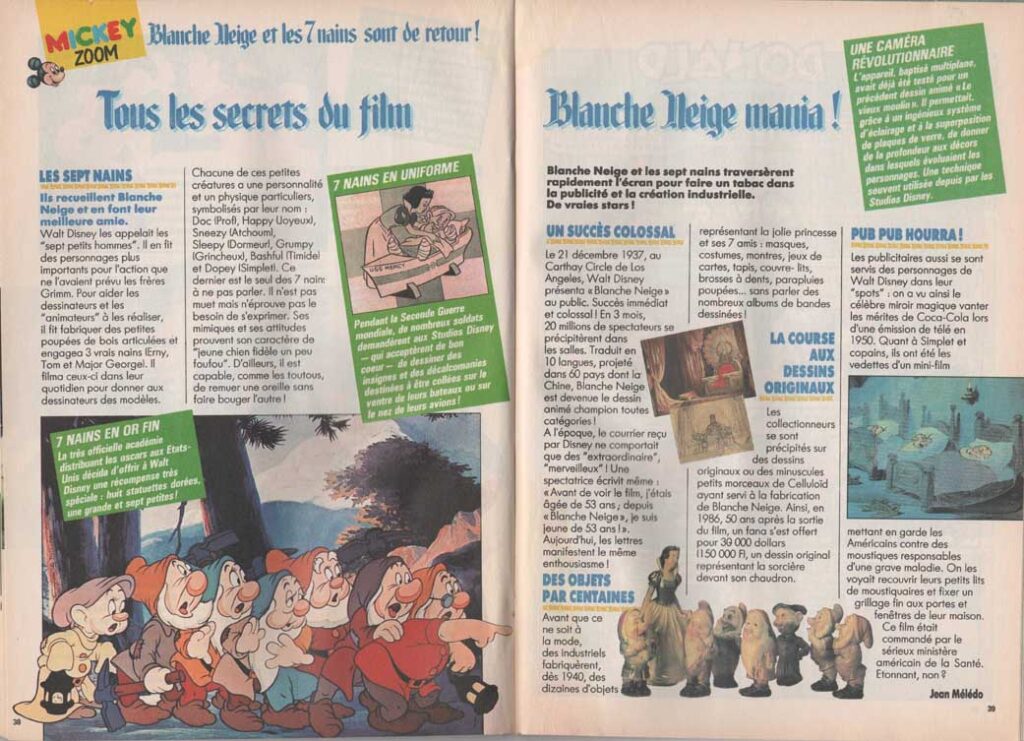
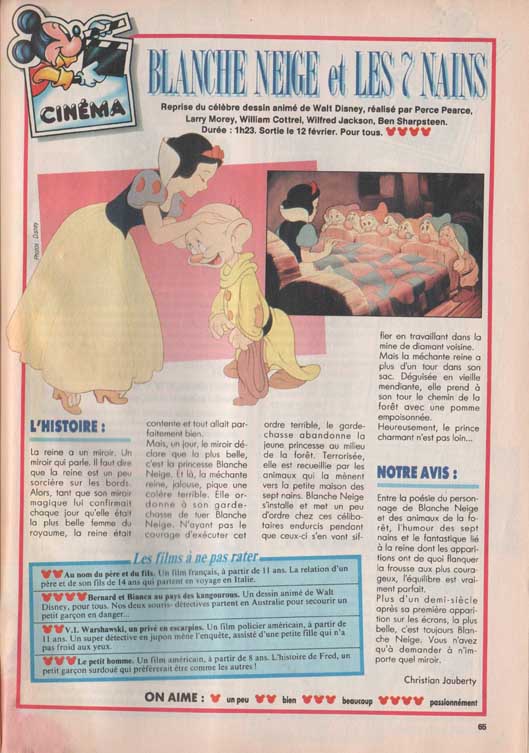
CINEMA
SNOW WHITE AND THE SEVEN DWARFS
Re-release of the famous animated film by Walt Disney, directed by Perce Pearce, Larry Morey, William Cottrell, Wilfred Jackson, and Ben Sharpsteen.
Duration: 1h23. Release date: February 12. For all. ♥♥♥♥♥
THE STORY:
The queen has a mirror. A mirror that talks. It must be said that the queen is a bit of a witch. As long as her magic mirror confirmed every day that she was the most beautiful woman in the kingdom, the queen was content and everything was perfectly fine.
But one day, the mirror declares that the most beautiful is the princess Snow White. And that’s when the wicked queen, jealous, flies into a terrible rage. She orders her huntsman to kill Snow White. Lacking the courage to carry out this terrible order, the huntsman abandons the young princess in the middle of the forest. Terrified, she is taken in by animals who lead her to the small cottage of the seven dwarfs. Snow White settles in and tidies up the home of these famous little bachelors while they go off whistling to work in a nearby diamond mine.
But the wicked queen has more than one trick up her sleeve. Disguised as an old beggar, she makes her way into the forest with a poisoned apple. Luckily, the prince is not far away…
OUR OPINION:
Between the poetry of Snow White’s character and the loves of the forest, the humor of the seven dwarfs, and the fantastical elements linked to the queen who will frighten the bravest, the balance is perfect.
More than half a century after her first appearance, the fairest of them all is still Snow White, Ask any mirror.
Christian Jauberty
Snow White and the Seven Dwarfs in video and DVD!
by Unknown journalist (October 17, 2001)
Snow White comes out for the first time on DVD in France in October 2001 and Mickey’s Newspaper dedicates its n°2574 issue to the little Princess. It contains two articles to promote the last VHS and first DVD release to a new generation of eager children.
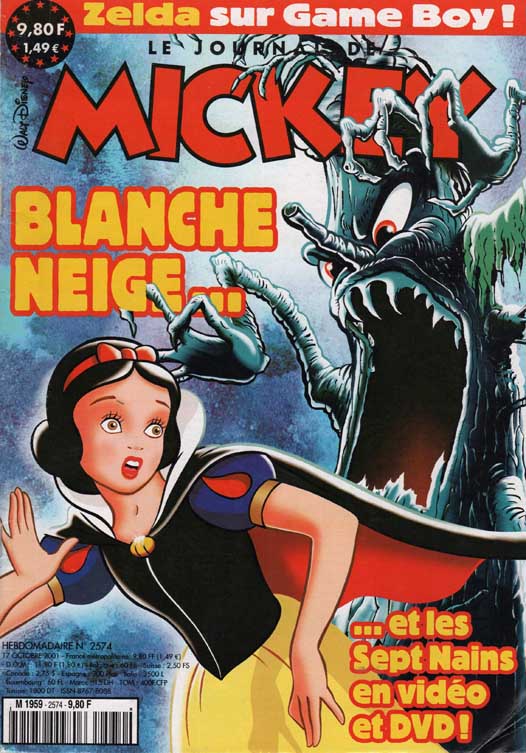
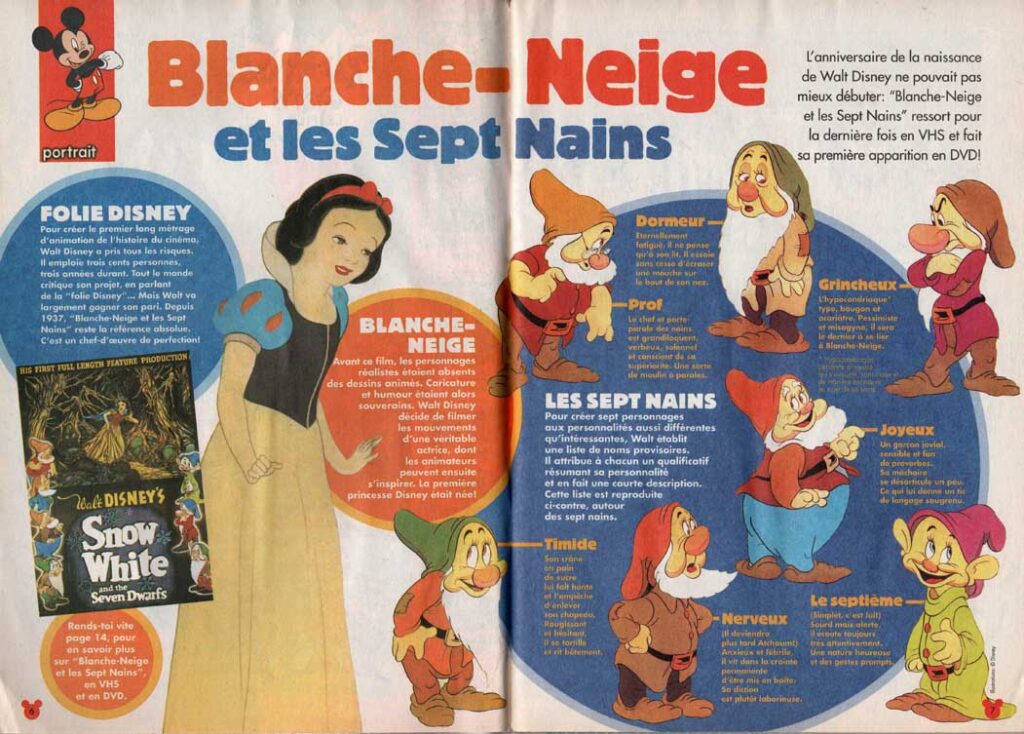
Snow White and the Seven Dwarfs
The anniversary of Walt Disney’s birth couldn’t have started better: Snow White and the Seven Dwarfs is being re-released for the last time on VHS and is making its first appearance on DVD!
DISNEY’S FOLLY
To create the first animated feature film in cinema history, Walt Disney took every risk. He employed three hundred people over three years. Everyone criticized his project, calling it “Disney’s folly”… But Walt would more than prove them wrong. Since 1937, Snow White and the Seven Dwarfs remains the ultimate benchmark. It is a masterpiece of perfection!
SNOW WHITE
Before this film, realistic characters were absent from animated films. Caricature and humor reigned supreme. Walt Disney decided to film the movements of a real actress, which the animators then used for inspiration. The first Disney princess was born!
THE SEVEN DWARFS
To create seven characters with personalities as different as they were interesting, Walt drew up a list of provisional names and assigned each one a trait summarizing their personality, along with a brief description.
This list is reproduced here, featuring the seven dwarfs.
- Sleepy
Perpetually tired, he thinks only of sleeping. He constantly tries to swat a fly off the tip of his nose. - Doc
The leader and spokesperson of the dwarfs is pompous, verbose, solemn, and fully aware of his own superiority. A real chatterbox. - Grumpy
The classic hypochondriac, grouchy and cantankerous. Pessimistic and misogynistic, he will be the last to warm up to Snow White. (Hypochondriac: a person who constantly and excessively worries about their health.) - Bashful
Ashamed of his cone-shaped head, he refuses to take off his hat. Blushing and hesitant, he squirms and giggles nervously. - Jumpy
(Eventually became Sneezy) Anxious and jittery, he lives in constant fear of being mocked. His speech is rather labored. - Happy
A jovial, sensitive fellow who loves proverbs. His jaw is slightly loose, giving him a quirky speech tic. - The Seventh
(This is Dopey!) Deaf but alert, he always listens very attentively. A cheerful nature with quick and lively gestures.
Snow White and the Seven Dwarfs
The greatest animated film ever made! So perfect that it remains just as modern, even more than sixty years after its creation! A masterpiece? That’s an understatement…
The Action
One evening in 1934, as the animators were returning from dinner, Walt greeted them, all excited:
“Come to the stage, I have something to tell you…” For two hours, Walt narrated and acted out the story of Snow White.
“This will be our first feature-length film!”
The Vision
By 1934, Walt had already invented Mickey and Donald. Each of his new animated shorts brought innovations. Walt even created a school to help his animators improve! But he wanted to go even further…
The Success
Disney invested all his money and energy into Snow White and the Seven Dwarfs.
The film, presented to the public for the first time on December 21, 1937, was a colossal success.
It became the world’s first feature-length animated film!
Since 1937, Snow White has remained the ultimate benchmark of the genre.
“Snow White and the Seven Dwarfs” will only be available in stores for a few months. After that, you’ll have to wait years!
- VHS. You’ve been warned: this is the last edition of the animated film in this format (130 F)!
- DVD. The fully restored film comes with the “Heigh Ho” karaoke track, an interactive game, and a never-before-seen documentary about its creation (180 F)!
- Collector’s DVD. On the second DVD, packed with stunning documents (including five unreleased sequences), you’ll discover the seven dwarfs in an all-out brawl or eating their soup like pigs. Thankfully, Snow White steps in to set them straight (200 F)!


